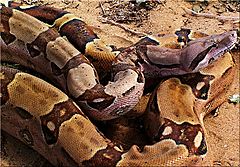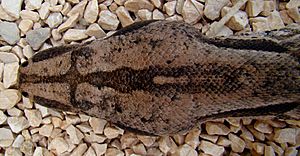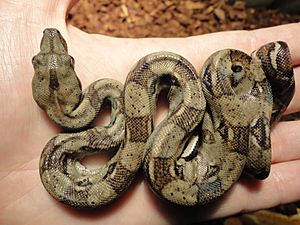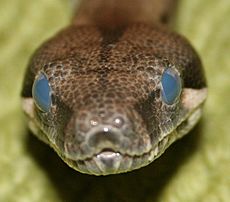Boa constrictor facts for kids
Quick facts for kids Boa constrictor |
|
|---|---|
 |
|
| Scientific classification | |
| Kingdom: | |
| Class: | |
| Order: | |
| Family: | |
| Genus: |
Boa
|
| Binomial name | |
| Boa constrictor Linnaeus, 1758
|
|
Boa constrictor is a non-venomous Boa species. The snake can be found in Central and South America, and on some islands in the Caribbean. The common name is the same as the scientific name, which is unusual. The color pattern of its skin can vary considerably. Boa constrictors grow to a large size. There are ten subspecies.
Contents
Description
Size and weight
The size adult animals reach varies among subspecies. The largest animals have been found in Northern south America. The largest documented non-stretched dry skin is deposited at Zoologische Staatssammlung München (ZSM 4961/2012) and measures 14.6 ft (4.45 m) without head. A report of a boa constrictor growing up to 18.5 ft (5.6 m) was later found to be a misidentified green anaconda.
Boas can reach lengths from 3 to 13 ft (0.91 to 3.96 m) depending on the locality and the availability of suitable prey. Females are generally larger in both length and girth than males. The usual size of mature female boas is between 7 and 10 ft (2.1 and 3.0 m) whereas males are between 6 and 8 ft (1.8 and 2.4 m). Females commonly exceed 10 ft (3.0 m), particularly in captivity, where lengths up to 12 ft (3.7 m) or even 14 ft (4.3 m) can be seen.
Coloring
Boas have a color pattern that is brownish, and becomes brick red around the tail. The coloring works as a very effective camouflage in the jungles and forests of its natural range. Dorsally, the ground color is overlaid with a series of large tan-colored saddles that become lighter towards the tail. Here, the saddles break up into half rings of a pale cream color in vivid contrast with the red. This coloring gives B. constrictor species the common name of "red-tailed boas."
Some individuals exhibit pigmentary disorders, such as albinism. Although these individuals are rare in the wild, they are common in captivity, where they are often selectively bred to make a variety of different color "morphs".
Features
Boas can use their tail to grasp things. This is known as prehensility. Boa constrictors can sense heat via cells in their lips.
Boa constrictors also have two lungs, a smaller (non-functional) left and an enlarged (functional) right lung to better fit their elongated shape.
Distribution and habitat
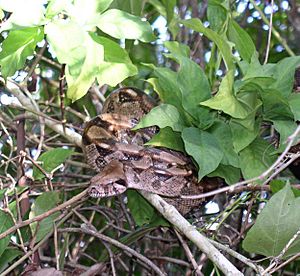
Depending on subspecies, Boa constrictor can be found through Central America (Belize, Guatemala, Honduras, El Salvador, Nicaragua, Costa Rica, and Panama) to South America north of 35°S (Colombia, Ecuador, Peru, Venezuela, Trinidad and Tobago, Guyana, Suriname, French Guiana, Brazil, Bolivia, Uruguay, and Argentina), and in the Lesser Antilles (Dominica and St. Lucia), on San Andrés, Providencia and many other islands along the coasts of Mexico and Central and South America. An introduced population exists in extreme southern Florida, and a small population on St. Croix in the US Virgin Islands now appears to be reproducing in the wild. The type locality given is "Indiis" – a mistake, according to Peters and Orejas-Miranda (1970).
B. constrictor flourishes in a wide variety of environmental conditions, from tropical rainforests to arid semidesert country. However, it prefers to live in rainforest due to the humidity and temperature, natural cover from predators, and vast amount of potential prey. It is commonly found in or along rivers and streams, as it is a very capable swimmer. Boa constrictors also occupy the burrows of medium-sized mammals, where they can hide from potential predators.
Behavior
Boa constrictors generally live on their own, and do not interact with any other snakes unless they want to mate. They are nocturnal, but they may bask during the day when night-time temperatures are too low. As semi-arboreal snakes, young boa constrictors may climb into trees and shrubs to forage; however, they become mostly terrestrial as they become older and heavier. Boa constrictors strike when they perceive a threat. Their bite can be painful, especially from large snakes, but is rarely dangerous to humans. Specimens from Central America are more irascible, hissing loudly and striking repeatedly when disturbed, while those from South America tame down more readily. Like all snakes, boa constrictors in a shed cycle are more unpredictable, because the substance that lubricates between the old skin and the new makes their eyes appear milky, blue, or opaque, so that the snake cannot see very well, causing it to be more defensive than it might be otherwise.
Hunting and diet
Prey includes a wide variety of small to medium-sized mammals and birds. The bulk of their diet consists of rodents, but larger lizards and mammals as big as ocelots are also reported to have been consumed. Young boa constrictors eat small mice, birds, bats, lizards, and amphibians. The size of the prey item increases as they get older and larger.
Boa constrictors are ambush predators, so often lie in wait for an appropriate prey to come along, when they attack. However, they have also been known to actively hunt, particularly in regions with a low concentration of suitable prey, and this behaviour generally occurs at night. The boa first strikes at the prey, grabbing it with its teeth; it then proceeds to constrict the prey until death before consuming it whole. Unconsciousness and death likely result from shutting off vital blood flow to the heart and brain, rather than suffocation as was previously believed; constriction can interfere with blood flow and overwhelm the prey's usual blood pressure and circulation. This would lead to unconsciousness and death very quickly. Their teeth also help force the animal down the throat while muscles then move it toward the stomach. It takes the snake about 4–6 days to fully digest the food, depending on the size of the prey and the local temperature. After this, the snake may not eat for a week to several months, due to its slow metabolism.
Reproduction
Boa constrictors are viviparous, giving birth to live young. They generally breed in the dry season—between April and August—and are polygynous; thus, males may mate with multiple females. The gestation period is around 100–120 days. The female then gives birth to young that average 15–20 in (38–51 cm) in length. The litter size varies between females but can be between 10 and 65 young, with an average of 25. The young are independent at birth and grow rapidly for the first few years, shedding regularly (once every one to two months).
Captivity
This species does well in captivity, usually becoming quite tame. It is a common sight in both zoos and private reptile collections. Though still exported from their native South America in significant numbers, they are widely bred in captivity. When kept in captivity, they are fed mice, rats, rabbits, chickens, and chicks depending on the size and age of the individual. Captive life expectancy is 20 to 30 years, with rare accounts over 40 years, making them a long-term commitment as a pet. The greatest reliable age recorded for a boa constrictor in captivity is 40 years, 3 months, and 14 days. This boa constrictor was named Popeye and died in the Philadelphia Zoo, Pennsylvania, on April 15, 1977. Proper animal husbandry is the most significant factor in captive lifespan; this includes providing adequate space, correct temperatures and humidity, and suitable food items.
Economic significance
Boa constrictors are very popular within the exotic pet trade and have been both captured in the wild and bred in captivity. Today, most captive boa constrictors are captive-bred, but between 1977 and 1983, 113,000 live boa constrictors were imported into the United States. These huge numbers of wild-caught snakes have put considerable pressure on some wild populations. Boa constrictors have also been hunted for their meat and skins, and are a common sight at markets within their geographic range. After the reticulated python, boa constrictors are the snake most commonly killed for snakeskin products, such as shoes, bags, and other items of clothing. In some areas, they have an important role in regulating the opossum populations, preventing the potential transmission of leishmaniasis to humans. In other areas, they are often let loose within the communities to control the rodent populations.
Conservation
All boa constrictors fall under CITES and are listed under CITES Appendix II, except B. c. occidentalis, which is listed in CITES Appendix I.
In some regions, boa constrictor numbers have been severely hit by predation from humans and other animals and over-collection for the exotic pet and snakeskin trades. Most populations, though, are not under threat of immediate extinction; thus, they are within Appendix II rather than Appendix I.
Boa constrictors may be an invasive species in Florida.
Images for kids
See also
 In Spanish: Boa constrictora para niños
In Spanish: Boa constrictora para niños


